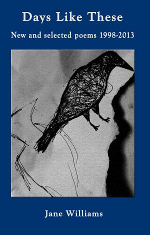
Days Like These: New and Selected Poems 1998-2013 by Jane Williams
Interactive Publishers, 2013
Days Like These: New and Selected Poems 1998-2013, by Jane Williams, includes new work and selections from Outside Temple Boundaries (1998), The Last Tourist (2006) (both published with Five Islands Press), Begging the Question (2008) from Ginninderra Press and City of Possibilities (2011) from Interactive Press. It’s always a pleasure to discover the writings of a poet who you have not read before. In Days Like These Jane Williams delivers poetry that wants to feel the ‘pulse of every living thing’; she is a writer sensitive to the world.
In 2011 Williams participated in the Red Room Company’s Clubs & Societies project, working with The Hobart Bell Ringers, a group who ring the bells at St David’s Cathedral and Holy Trinity Church in Hobart, Tasmania. A villanelle titled ‘The bell ringers’(p.105) included in the ‘New Poems’ section of the book (and written for the RRC project) explores many of Williams’ preoccupations in the collection. The image of the bell ringers as‘a circle of ten at the end of each swing’ who ‘stand together alone’ serve as a useful metaphor for the whole collection; this is poetry that both pursues and examines the ‘balance of things’, it delves into our contemporary sense of isolation despite our ‘togetherness’ and explores momentary wonder, it is concerned with faith and the narratives that underpin it. ‘The bell ringers’is the place where the repetitive patterning of life, the intersect between body and experience, sense and belief are written,
Memory relives all the body has known. The senses reach back, the spirit takes wing. The church bells ring out caressing the stone. The bell ringers stand together alone. ‘The bell ringers’ p.105
There is a sense of movement and development in the collection, attributable to, in part, the work being a review of the poet’s work to date. To refer to that bell ringers’ image again –it’s as if we are standing at different points in a room and interpreting subtle shifts in perception. This shift is apparent in the poet’s increasing employment of questions as a tool in the latter poems. Judith Beveridge once noted in a review of Louise Gluck’s poetry that questions are ‘like nodes which allow for openings and possibilities, points of intersection between speaker and reader’*, and I think this is true for Williams’ work. In ‘ Watching the wind surfer’, a poem about avoiding the ordinary and embracing a kind of celebratory abandonment, the poet asks ‘what happens next/ doesn’t happen outside the poem or does it?’ (p103) .
Williams revisits popular Christian narratives of faith throughout Days Like These, particularly in poems from her Outside Temple Boundaries. In the poem ‘Magdalene’ Williams writes of the three women who loved Christ enough to ‘confuse history’. This sense of confusion, of simultaneous oppression and thankfulness, is frequently revisited; from the instinctual ‘head heart left right shoulder’ sign of the cross (‘Emissary’, p.27) to ‘moments /unasked for/miraculous’(‘Notes to daughters’, p76). Williams is unafraid to examine the foundations of her Irish Catholic upbringing and to admit to hope for ‘ordinary miracles’. Though it’s a hope tempered with realism. In ‘On entering the city of possibilities’ she states; ‘Search for meaning. Briefly. It’s not worth the grief’. In the beautiful ‘Inventing a god’ the poet explores the invention of her own god‘(a) child god// whose worlds are/ant hill bird nest cloud shape’ or a ‘brave god// …who would send her own ghosts on ahead/to light the way/’ to gift to a lover or child.
I was struck particularly by the terrific use of heart imagery throughout Williams’ selected works. Hearts are ‘petrified’, ‘frantic’, ‘transplanted’, ‘clockwork’, or ‘pure’. There is ‘the seascape of the heart’and ‘tortoise hearts…with their slow and steady beat’. Williams’ confident use of the heart as a central motif reveals a poet who uses emotional response as an entry point or conduit into the writing. In ‘How the heart works’ (p.23) Williams’ narrator is fleeing the trauma of memory, desiring only to own again a fragile, impossible protector.
the plastic Jesus lamp with the red flashing heart to watch over the blue chipped ceramic virgin who watches over you
‘The heart’s departure points’(p.68), from City of Possibilities, is one of my favourite poems in the collection. The narrator demands answers to questions of lost and found love, decisions made, possible futures, grief, life’s vagaries, and the art of survival. The work here is dense, intimate and relentless.
… I know grief can tempt me barefoot through snake infested country or needlepoint alleys – anywhere the odds are high and the gods are out of town. But to deny it is to settle for less so I find myself describing the contours of a dislocated brain, the dream life of a transplanted heart.
These are gentle and surprising poems, relating to family and the quiet observation of life as it happens. Poems such as ‘Thirst’, ‘When the world was lollies’, ‘After hours’ and ‘Visiting Daughter’ will make you smile. Yet to suggest that the writing is of the ‘everyday’, or quotidian, is to misrepresent Williams’ sense of wonder and her vivid engagement with the world. I particularly enjoy poetry that explores intimate territory – family, memory, love, moments of ‘small talk’ – and manages to surprise me. Who doesn’t like to rediscover wonder in the ordinary?













